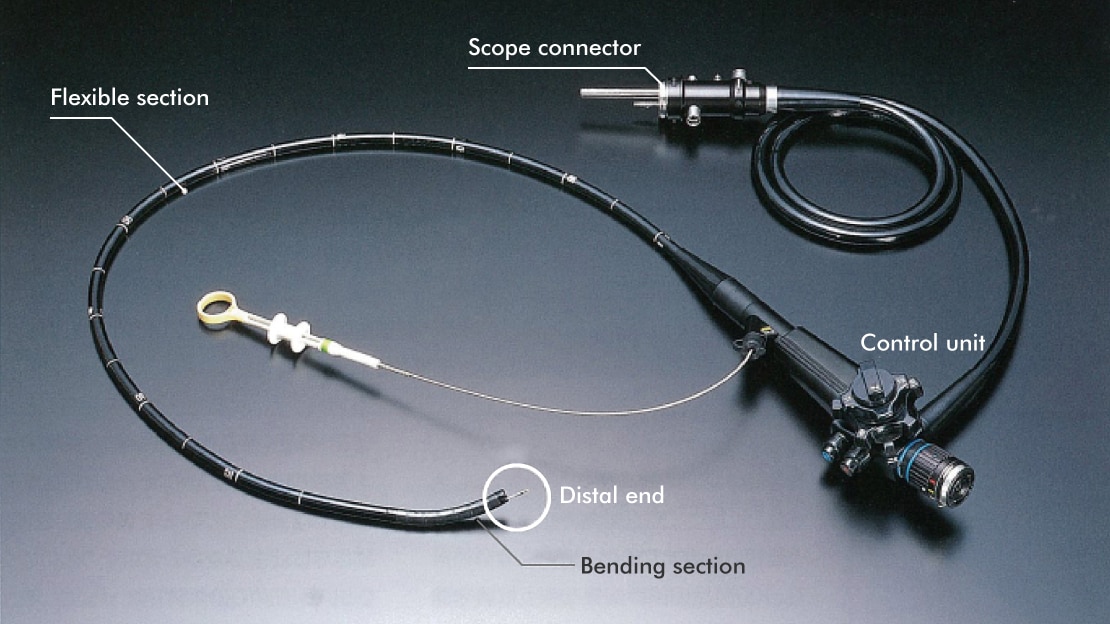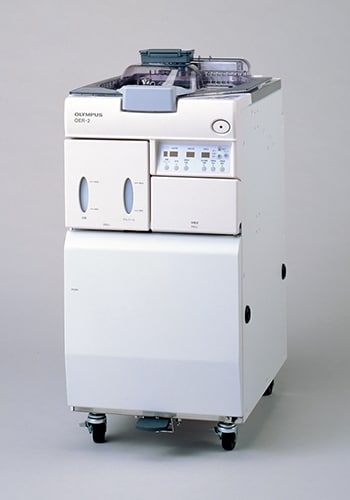Our work makes a genuine contribution to society through medical treatment, and we will continue to approach our activities with a sense of pride and mission as we endeavor to discover a wide range of needs and provide tangible solutions to those needs. We see the creation of endoscopes as the creation of true value, and as the realization of our corporate philosophy.
Medical Professionals
Making Reliable Products to Meet the Diverse Needs of Medical Professionals
The first Olympus gastrointestinal endoscope, developed in 1950, was used in testing in a branch hospital of the University of Tokyo Hospital.
Olympus has continued to develop new products and technology in this field, putting the changing needs of medical professionals into the reliable material objects. Development engineers are continually analyzing customer requirements and those needs are reflected in new products, always making safety their top priority. Production is a process of giving form to every need through the creation of products. This is exemplified by the "Olympus Endoscopy System (OES)"*. The corporate DNA that inspires this dedication to user needs is engendered in the extensive Olympus product range, including endotherapy devices.
Whatever the Need, We Start by Giving it Shape
Like medical professionals, people involved in the production of endoscopes are inspired by a desire to contribute to the good of society through medical treatment. They listen carefully to the needs of medical professionals, and they strive to create quality products that match those needs down to the finest detail. This attitude is the guiding principle of all stages of production, from product development through manufacturing.
We receive all sorts of requests concerning endoscope products. Our task at the product development stage is to give form to these needs. This work is an essential foundation for recognition in the medical community. There are situations where we know that we have reached the limits of an existing technology, and yet, we take up the challenge of breaking through those limits to meet the needs of users. When developers, designers and prototype engineers combine their talents to tackle these challenges, new opportunities to overcome technological obstacles arise. Our ability to give form to needs is the result of collaboration between developers, who understand user needs and are able to bring that knowledge into the development process, and prototype engineers, who turn needs into actual products making full use of their skills and technical knowledge.
Creating World Standards through Repeated User Testing of Prototypes
To gauge the operating characteristics of an endoscope and finalize its specifications, first we create a prototype that reflects user needs. This allows detailed desk assessment to be carried out. This is the start of a careful step-by-step process of prototype refinement based on repeated testing and feedback.

The fully waterproof "OES Series"
For example, the OES*1we introduced in 1983 was the first fully-waterproof as Olympus product (able to withstand immersion in chemical solutions for many hours). This feature met one of the essential needs of medical professionals, who wanted to disinfect the whole endoscope (formerly, only the inserted section of the endoscope) by immersing it in solution, and eventually it became the standard for cleaning and disinfecting endoscopes. A number of innovations were needed, including new materials, new waterproofing, and control structures, and the final design was the result of repeated cycles of creating a prototype and checking its performance. Molded components made from engineering plastics were the key parts to make the endoscope waterproof. Few people in Olympus or any other organization had extensive experience in using these materials, however, and development began with the study of elemental technologies, including materials, strength design, and molding methods. Test samples produced under various molding conditions and with various dimensions were repeatedly subjected to waterproofing and chemical-proofing tests. The structure also incorporated a totally new concept. Instead of using screws to fix the plastic components in place, the components were designed in a securely interlocking shape. Because design conditions, including optimal conditions for molding and affixing the components could not be deduced through logic, the designers reached their goal by repeatedly creating and assessing generation after generation of prototypes and accumulating knowledge through trial and error. In addition to our own tests, a theoretical framework was developed using information gathered from technical literature and other sources. The tests were then repeated. This assiduous tenacity eventually led to the adoption of a waterproof design.
Olympus Leaves No Stone Unturned in Seeking Out Needs, and Reflecting those Needs in Our Products
Each medical professional use endotherapy devices in a subtly unique way, and Olympus has developed a wide variety of product types to meet all user needs. Devices are tools, and needless to say, practitioners always want tools that are easy to use. Competitiveness depends above all on our ability to seek out the needs of medical professionals and reflect those needs in our products before others do. Needs are actually identified in one of two ways: the ideas that come from the medical professionals themselves, and the discovery of potential needs by the manufacturer. There is no doubt that reliable ideas coming from users obviously reflect user needs. The discovery of potential needs that the users themselves are not even yet aware of is vital to the continuing creation of further competitive products. One way of drawing out potential needs is visiting hospitals from day to day occasionally and simply talking with medical professionals. As development engineers are not allowed to perform actual medical procedures, they assess the feel and ease of use of the products by means of simulations using models of the stomach or duodenum. In addition, information is gathered from all possible sources, including scientific papers and market evaluations, and is carefully analyzed. Finally a mock-up of the product is created and shown to medical professionals and this sometimes provides the stimulation needed to recognize a new need. Once a new need is recognized, consideration is then given to the development of the finished product. The prototype engineers are continually gathering information about new processing methods and materials and conducting research into techniques. They are always ready to create a product to meet any need. Success depends on our ability to put the product in front of users without delay.

An endoscope reprocessor (washing and disinfecting system)
* The Olympus Endoscopy Sys-tem (OES) has radically changed the field of endoscopy. Because endoscopes are inserted into the patient's body, disinfection is a major priority. Because the entire OES is waterproof, it can be fully immersed into disinfectant solution.

